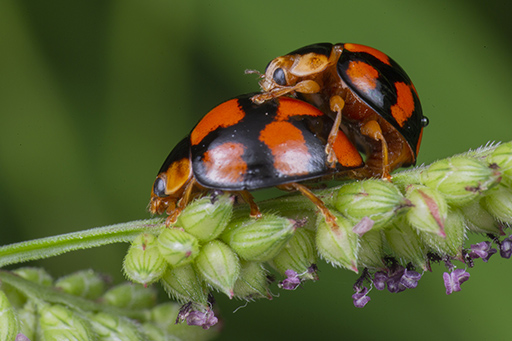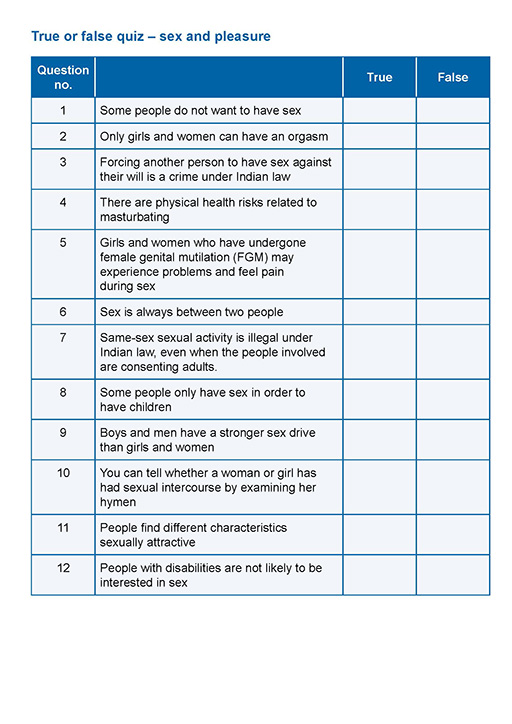Use 'Print preview' to check the number of pages and printer settings.
Print functionality varies between browsers.
Printable page generated Thursday, 20 November 2025, 12:11 PM
Learning Session 6: Sexual behaviours and practices
Introduction
This learning session helps you to include sexual pleasure within your CSE sessions when you are focusing on sexual behaviours and practices.
Sexuality education usually includes discussion on sexual behaviours and practices, but often any mention of sexual pleasure is excluded from these sessions. Discussing issues like contraception and safer sex is very important, but, as you will now realise from previous sessions, it is not comprehensive and sex-positive sexuality education without including sexual pleasure.
As an educator, your role is to help the young people you work with to think more critically about the many, often contradictory, messages about sexuality they receive every day from their families, the media and educational institutions, to help them work out what they want for themselves.
Like the other learning sessions in Part 2 of this resource, this learning session aims to offer you lots of activities to use within your existing CSE sessions. There are some activities to do yourself to help you prepare, and some activities to use within your CSE sessions. By the end of this session you should:
- Have some new ideas about how to include pleasure within CSE sessions you are leading which focus on sexual behaviours and practices.
- Feel more confident about including pleasure within these sessions.
6.1 Did you know?
This first activity is for you to do yourself, to help you prepare for CSE sessions.
Activity 6.1: Test your sexual knowledge: Did you know?
This activity is in the form of a simple quiz to test what you already know about sex. Answer the following four questions:
a.
18%
b.
25%
c.
54%
d.
82%
The correct answer is a.
Answer
Scientific studies regularly show that vaginal intercourse without clitoral stimulation does not lead to orgasm for the majority of women.
One recent large-scale study found that only 18% of women said that vaginal intercourse alone would lead to orgasm, whereas 36% of women reported that they needed clitoral stimulation as well to experience orgasm and a further 36% reported that their orgasms felt better if their clitoris was stimulated (Herbenick et al., 2018).
Many women mentioned 'spending time to build-up arousal', 'having a partner who knows what I like', and 'emotional intimacy' as techniques which enhance their orgasms. Another study showed that men more often experience orgasm from sex than women. However, it also showed that women in same-sex relationships experience orgasms more often than those in different-sex relationships (Garcia et al., 2014).
Discussion
It’s really important for a woman’s partner to know what she wants sexually and what turns her on. The chances of finding out what our partners like by accident is slim. It’s much better to talk about it. It’s also important to remember that people can experience sexual pleasure without having orgasms.
a.
No
b.
Yes
The correct answer is a.
Answer
No! Men can ejaculate without feeling the pleasure of orgasm and have an orgasm without ejaculating (Masters and Johnson, 1966).
Discussion
An ejaculation is not the same as an orgasm, but often they occur simultaneously.
a.
Higher than this?
b.
Lower than this?
The correct answer is a.
Answer
It is very hard to get reliable information about this because people don’t always reply truthfully to questions about porn use, even when they are anonymous.
Whether young people have watched porn will also vary depending on the region or country, as well as on an individual’s gender, age, background, access to a mobile phone, and other personal characteristics.
However, we do know that rates of porn use by young people are growing all over the world – for example, a study of young people in Nordic countries undertaken as long ago as 2006 found that 99% of boys and 86% of girls had watched porn by the age of 14 (Sørensen and Knudsen, 2006).
So it is probably safe to assume that most Indian young people these days will have seen porn before their first sexual experience with another person.
Discussion
Porn can be fun – people can use it to get aroused or to find out about different sexual practices. But it can also portray negative stereotypes about ‘masculine’ and ‘feminine’ desire and place unrealistic expectations on young people about what ‘good’ sex is.
It’s really important to be able to tell the difference between the fantasies in porn and real life.
a.
No
b.
Yes
The correct answer is a.
Answer
No. Ideally, sex should be about giving – and receiving – pleasure, but this isn’t always the case.
Sometimes people consent to sex within a long-term relationship even though they don’t feel desire (Vannier & O’Sullivan, 2010). Some people report never experiencing pleasure from sex. In one large scale UK study, 0.5 % of respondents reported that they had never experienced sexual attraction to anyone (Bogaert, 2012) – some of these people might describe themselves as ‘asexual’.
Discussion
Physically there are all kinds of things that may stop people experiencing pleasure during sex, such as erectile dysfunction or painful intercourse. Also, people with some disabilities may need additional tips and practice to find ways to feel pleasure from the physical aspects of sex.
Being unhappy in a relationship, or social and cultural norms, can also stand in the way of experiencing sexual pleasure. The expectations that “women should be inexperienced and reject approaches” and that “men should always want sex and be experienced” can place severe pressure on young people.
Being educated about the positive elements of physical sexual activity can have a major effect on young people’s confidence and self-esteem and, consequently, their attitude toward sex.
6.2 What counts as sex?
The next activity is designed for you to use within a CSE session. It asks participants to think more deeply about what they mean by ‘sex’.
It aims to demonstrate how sex can mean different things to different people and that there are many more sexual practices possible than just penis-in-vagina intercourse.
Activity 6.2: What is sex?
Step 1: Tell the group that the aim of this activity is to think about what we mean by ‘sex’. Divide people into groups of between 3 and 5. Tell them they have 5 minutes to think of as many things as they can that they think count as ‘sex’.
Step 2: Ask the groups to give some feedback to the class, and write down their ideas on a chalkboard or large piece of paper. Ask questions about the answers they give to help challenge the attitudes and assumptions behind them. For example:
- Is sex something that only relates to the genitals? What other parts of the body can be part of sex? (e.g. Hands, mouth, nipples? Other sensitive places on the body? It depends on the individual?)
- Is sex always something that takes place between two people who are in the same space? (No, it can be with oneself – masturbation – or with someone who is not in the room – sexting, telephone sex – or consider the possibility that more than two people can be involved.)
- Is it still sex if one partner does not have an orgasm? (Yes. Some people do not experience or want orgasms, or not on every occasion that they experience sexual pleasure).
- Does everyone want to have sex? (Here you can talk about the fact that sexual desire can increase and decrease as we age, and can depend on other life factors. You should also mention that some people do not experience sexual desire at all – this is called being ‘asexual’)
- It sounds as if you are saying that everyone likes the same kind of sex, but can people be turned on by different things (dressing up, nudity, fantasy, surroundings, etc.)?
- If it sounds as if sex is always positive or negative, why do you think this is? (Here you can discuss pleasure and joy or force and abuse)
- Is sex all about technique and positions? What about mood, desire, fantasies, pleasure?
6.3 Exploring dilemmas
The next activity helps participants to reflect on the dilemmas young people experience and to explore different options for actions.
There are no right or wrong answers, but several possibilities to think about and discuss.
Activity 6.3: Sex, boundaries and pleasure
Note: This activity is best suited to a larger group or class.
Step 1: Divide the group into four smaller groups. Ask each group to stand in one corner or area of the room or space you are working in. Read Case study 1 to the group and give them the four options. Allocate one option to each group.
Case study 1
Sunil and Annu have been partners for a long time and are very much in love. Neither of them has had sex with anyone else before. They are planning to have sex together and have already bought condoms, but Sunil is having second thoughts. He is insecure about how they can make it a good experience for both. What should Sunil do?
Option 1: He should talk to Annu about it, so they can talk about what they like and plan to have sex.
Option 2: It is too embarrassing to talk about sex. He should just go ahead – they will find out along the way what they both like.
Option 3: He should get advice from someone he trusts in his family, among his friends or someone else.
Option 4: He should tell Annu that he cannot have sex with her.
Step 2: Tell each group to come up with arguments for the answer they have been given. After 5 minutes’ discussion, ask them to present their arguments to the whole group.
Step 3: Now tell the participants to move to the corner or space that represents their own view, rather than the view they had to argue before.
Step 4: Lead a discussion about the case study using these questions:
- What advantages and disadvantages are there to the different options?
- Which issues about sex and pleasure did the case study raise?
- What different possibilities for acting in regard to sex and pleasure did the case study raise?
Important points to note:
- No one has the right to sex, but everyone has the right to say no.
- If the young people are surprised that the man is hesitant in this story, talk to them about the fact that society often expects men to want sex and women to be more hesitant, but this is not always true. Women’s desire can be as strong and diverse as men’s.
- You can also discuss some of the dilemmas that Annu might face herself, whether she does or doesn’t choose to have sex.
Step 5: Divide the group into four smaller groups again. Read Case study 2 out loud and give them the four options. Allocate one option to each group.
Case study 2
Kavya is 20 years old and has been married for 6 months. She and her husband have a good relationship but Kavya finds the sex a bit disappointing and sometimes a bit uncomfortable. She is not sure if she has ever had an orgasm. She learned in school that sex means penis-in-vagina sex and that’s what her husband seems to think too.
She's read women’s magazines that talk about different sex positions that feel good, and about sex toys that people sometimes use but she doesn’t know how to talk to her husband about trying them. What should she do?
Option 1: Buy a vibrator and try it out in private
Option 2: Talk to her husband about her dissatisfaction
Option 3: Talk to a trusted female friend or family member
Option 4: She should just accept that the sex isn’t brilliant because the rest of their relationship is good.
Step 6: Tell each group to come up with arguments for the answer they have been given. After 5 minutes’ discussion, ask them to present their arguments to the whole group.
Step 7: Now tell the participants to move to the corner or space that represents their own view, rather than the view they had to argue before.
Step 8: Lead a discussion about the case study using these questions:
- Which advantages and disadvantages are there to the different options?
- Which issues about sex and pleasure did the case study raise?
- What different possibilities for acting in regard to sex and pleasure did the case study raise?
Important points to note:
- Sex can be much more than penis-in-vagina sex and most women need clitoral stimulation to experience sexual pleasure.
- Masturbation can be a very good way to find out about your own body and what you like.
Further options for this activity:
You can extend this activity by changing the gender of the characters (Is it a girl or a boy who has the dilemma? Are the characters different genders or are they both the same?).
Or you can change the ages of the characters (Are the characters the same age or is one significantly older? What gender is the older character?).
Or you can change other aspects of their identities, like where they live or their family background. This allows you to explore and challenge young people’s assumptions and stereotypes about sexual practices.
You could also write your own case studies to explore other related issues.
6.4 Myths and facts quiz
Our next activity conveys factual information which can help to dispel myths and misconceptions about sex and pleasure. It also helps participants to be aware of where they get their information from.
Activity 6.4: True or false?
Preparation
Print off the quiz which you will find in the Image bank, or write the questions on a chalkboard or large piece of paper.
Step 1: Participants can answer the quiz individually, in pairs or in smaller groups, or the whole group can work together.
Step 2: When everyone has answered, go through the results. After each question, ask them if the answer surprised them, and where they got their knowledge from.
Step 3: Finish by asking how they think it could be made easier for young people to get reliable information about sexual and reproductive health.
Answer
The correct answers to the quiz are:
- True
- False
- True
- False
- True
- False
- False
- True
- False
- False
- True
- False
A physical variation on this activity
Alternatively, if a more physical activity would be useful to the session, you can call one side of the room or space ‘true’ and the other side ‘false’ and ask participants to move to whichever place they think is the right answer for that question. Then you can reveal the correct answer.
Summary
In this final learning session you have explored some resources to help you lead sessions on sexual behaviours and practices that include discussion of sexual pleasure. Having studied this session, you should now:
- Have some new ideas about how to include pleasure within CSE sessions you are leading which focus on sexual behaviours and practices.
- Feel more confident about including pleasure within these sessions.
Now collect your Statement of Participation.



